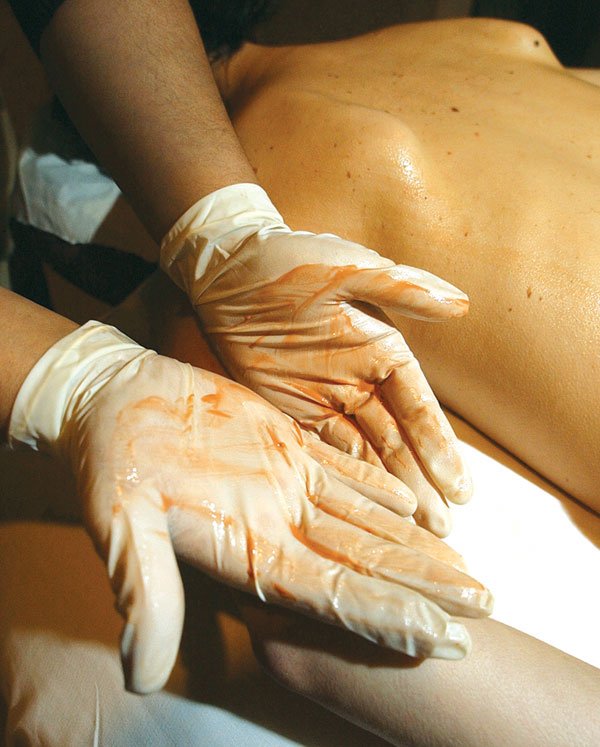You can never be too rich, too thin or too tan, and each year 28
million Americans find themselves baking on a beach or laying
prostrate in a blindingly bright tanning bed attempting to achieve
just one of those standards.
But an increasing number of consumers are turning away from the
conventional tan thanks to concerns over issues like cancer,
premature aging and skin damage.
You can never be too rich, too thin or too tan, and each year 28 million Americans find themselves baking on a beach or laying prostrate in a blindingly bright tanning bed attempting to achieve just one of those standards.
But an increasing number of consumers are turning away from the conventional tan thanks to concerns over issues like cancer, premature aging and skin damage. Instead, they’re embracing “fake bake” solutions that give them the golden bronze of a beach weekend without the risk or time investment.
Newer cream and spray applications, like the air brush method popular among Hollywood stars, don’t have the same nasty effects as their predecessors.
Rarely will they turn their wearers orange, and despite the fact that they offer no sun protection, they offer wearers a beach-worthy glow in just minutes rather than hours.
Sunless tanner, unlike the conventional process of tanning in the sun or under specialize lights, is a purely superficial treatment.
Essentially, it dyes the top-most layer of skin, an effect that lasts anywhere from three to 10 days depending on how quickly a person exfoliates. It does not cause skin damage, even though users look tan.
Drug stores offer at-home self-tanning options like Coppertone’s “Endless Summer” label, but to ensure the most even tan possible, locals turn to professionals for their applications.
At Skin Tech in Gilroy, for $30, owner Debra Rosas sprays clients with the color additive dihydroxyacetone, a chemical compound that goes on clear, but reacts with the body’s amino acids to produce a natural-looking tan that slowly develops over the next 24 hours.
It’s the same compound used in many over the counter tanners, so Rosas recommends testing an area for color before application as some medication or dietary issues can cause the tan to be discolored.
For those who prefer a more hands-on approach, Natural’s Salon and Day Spa in Morgan Hill offers customers a luxe, hands-on treatment known as the “Sun-kissed beauty glow.”
A technician exfoliates the client’s entire body, dry brushing it with hands, gloves and brushes before administering an exfoliating rub-down with either tangerine or lavender scented body scrub. When the client has showered off, the staff member massages in a sunless tanner from head to toe.
“A lot of our customers are about to go on vacation and they have to get into the swim suit and they want to look good,” said Naturals Manager Cindi Torres. “Another reason they come in is if they’re going to an event over the weekend and they want to have a little color.”
When the human body is exposed to excess ultraviolet light, UVA rays penetrate the skin damaging layers deeper under the surface and promoting the cosmetic effects of sun damage – wrinkling, age spots, mottling, and leathering of the skin as well as the breakage of capillaries.
They also create the warm brown color visible in tanned skin, the body’s attempt to protect itself from harsh burns by pumping up its melanin levels. UVB rays are a shorter wave length and are prone to cause the more visible effects of sunburn, like burning, blistering and flaking. UVB rays are also associated with the development of skin cancer later in life, said Dr. Pamela Stuart, physician and medical director for Physician’s Skin Solutions in Morgan Hill.
“There’s no such thing as a healthy tan, so the bottom line is UV radiation induces and promotes not only skin cancers, but premature wrinkling and aging,” said Stuart. “I think most people who do tanning know that, but are ignoring the facts until it becomes too late.”
Stuart said she regularly treats patients who have ignored these signs and lived to regret that choice when confronted with age spots or deep wrinkles.
She can reduce the effects of such damage using laser treatments like the new and ultra-advanced Lumenis One delivered to her office Monday, but her best advice is simple: Lather up with sunscreen to protect yourself or she’ll be seeing you later.
Two local tanning salons and one national supplier of tanning beds had no comment for this story. The other nine local tanning salons did not return telephone calls in time to comment for this story.
For more information on sunless tanning, call Debra of Skin Tech at (408) 848-8483 or Naturals at (408) 779-8466. For more information on treatment for damaged skin, call Stuart at (408) 778-4684.














